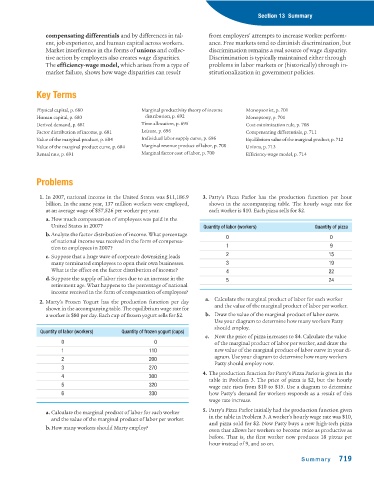Page 761 - Krugmans Economics for AP Text Book_Neat
P. 761
Section 13 Summary
compensating differentials and by differences in tal- from employers’ attempts to increase worker perform-
ent, job experience, and human capital across workers. ance. Free markets tend to diminish discrimination, but
Market interference in the forms of unions and collec- discrimination remains a real source of wage disparity.
tive action by employers also creates wage disparities. Discrimination is typically maintained either through
The efficiency-wage model, which arises from a type of problems in labor markets or (historically) through in-
market failure, shows how wage disparities can result stitutionalization in government policies.
Key Terms
Physical capital, p. 680 Marginal productivity theory of income Monopsonist, p. 701
Human capital, p. 680 distribution, p. 692 Monopsony, p. 701
Derived demand, p. 681 Time allocation, p. 695 Cost-minimization rule, p. 708
Factor distribution of income, p. 681 Leisure, p. 696 Compensating differentials, p. 711
Value of the marginal product, p. 684 Individual labor supply curve, p. 696 Equilibrium value of the marginal product, p. 712
Value of the marginal product curve, p. 684 Marginal revenue product of labor, p. 700 Unions, p. 713
Rental rate, p. 691 Marginal factor cost of labor, p. 700 Efficiency-wage model, p. 714
Problems
1. In 2007, national income in the United States was $11,186.9 3. Patty’s Pizza Parlor has the production function per hour
billion. In the same year, 137 million workers were employed, shown in the accompanying table. The hourly wage rate for
at an average wage of $57,526 per worker per year. each worker is $10. Each pizza sells for $2.
a. How much compensation of employees was paid in the
United States in 2007? Quantity of labor (workers) Quantity of pizza
b.Analyze the factor distribution of income. What percentage
0 0
of national income was received in the form of compensa-
tion to employees in 2007? 1 9
c. Suppose that a huge wave of corporate downsizing leads 2 15
many terminated employees to open their own businesses. 3 19
What is the effect on the factor distribution of income? 4 22
d.Suppose the supply of labor rises due to an increase in the 5 24
retirement age. What happens to the percentage of national
income received in the form of compensation of employees?
a. Calculate the marginal product of labor for each worker
2. Marty’s Frozen Yogurt has the production function per day
and the value of the marginal product of labor per worker.
shown in the accompanying table. The equilibrium wage rate for
a worker is $80 per day. Each cup of frozen yogurt sells for $2. b. Draw the value of the marginal product of labor curve.
Use your diagram to determine how many workers Patty
should employ.
Quantity of labor (workers) Quantity of frozen yogurt (cups)
c. Now the price of pizza increases to $4. Calculate the value
0 0 of the marginal product of labor per worker, and draw the
1 110 new value of the marginal product of labor curve in your di-
agram. Use your diagram to determine how many workers
2 200
Patty should employ now.
3 270
4. The production function for Patty’s Pizza Parlor is given in the
4 300
table in Problem 3. The price of pizza is $2, but the hourly
5 320 wage rate rises from $10 to $15. Use a diagram to determine
6 330 how Patty’s demand for workers responds as a result of this
wage rate increase.
5. Patty’s Pizza Parlor initially had the production function given
a. Calculate the marginal product of labor for each worker
and the value of the marginal product of labor per worker. in the table in Problem 3. A worker’s hourly wage rate was $10,
and pizza sold for $2. Now Patty buys a new high-tech pizza
b.How many workers should Marty employ?
oven that allows her workers to become twice as productive as
before. That is, the first worker now produces 18 pizzas per
hour instead of 9, and so on.
Summary 719

